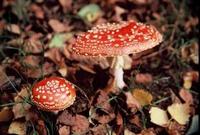Changing weather affecting fruits and fungi
 The weather has made a huge impact across the country in terms of floods, but it is also affecting the fruits and fungi in The National Forest. This year has seen a greater number of species flowering or fruiting earlier such as the primrose in early January and now blackberry and raspberry, which are already ripe but much smaller than usual.
The weather has made a huge impact across the country in terms of floods, but it is also affecting the fruits and fungi in The National Forest. This year has seen a greater number of species flowering or fruiting earlier such as the primrose in early January and now blackberry and raspberry, which are already ripe but much smaller than usual.Mushrooms, the fruiting bodies of the fungi, are usually seen in October but are already sprouting, which could be due to the extreme damp, in which some fungi thrive. It is unclear what effect this will have throughout the rest of the year and whether the fungi season will be extended.
Mother Nature is certainly challenging the identification books views on when certain fruits and flowers should be out, so now more than ever, it pays to go out with an expert!
Interest in edible wild plants has mushroomed over recent years with greater interest taken by the public in where their food comes from, and foraging is being rediscovered as a fruitful and fun family pastime.
To help visitors get to grips with the differences and similarities between harmless edible species and their poisonous cousins, there are now three bushcraft and survival schools in The National Forest. These run day, weekend or week-long courses where, in addition to learning the fundamental principles of survival and wilderness bushcraft, groups learn how to identify and cook edible plants, recognise specific trees and discover uses for different plants and trees.
Jason Ingamells, from Woodland Ways, said: “We have noticed changes to the Forest flora over the last couple of years, which we believe are due to the fluctuations in weather, for example extreme heat and near drought for prolonged periods followed by extreme wet for similarly long periods of time.”
Penny Wilkinson, Tourism & Promotions Officer with the National Forest Company commented:
“The National Forest is one of the few places in the country where you can come to the woodland and safely learn all about plants and their uses with experts who explain the effects that changes in the weather are having on the fruits of the Forest. There are also courses here for people to try their hand at traditional woodland crafts such as willow weaving, pole lathe turning and dry stone walling or weaving, textiles or painting.”
As well as these woodland experience’s, The National Forest has a huge number of historic places of interest such as Calke Abbey, Ashby de la Zouch Castle and Coors Visitor Centre, brilliant family attractions including Conkers and Snibston Discovery Centres and it is criss-crossed with peaceful woodland paths and bridleways to explore – whether by foot, by bike or on horseback.
For more information on where to go, what to see and places to stay in and around The National Forest, the 2007 visitor guides to the Forest and its immediate environs are bursting with great ideas.
The National Forest Company has also produced a pack of Forest walks from 3 to 22 miles long. These are available from Tourist Information Centres or from the National Forest Company directly by logging on to Nationalforest.org.

